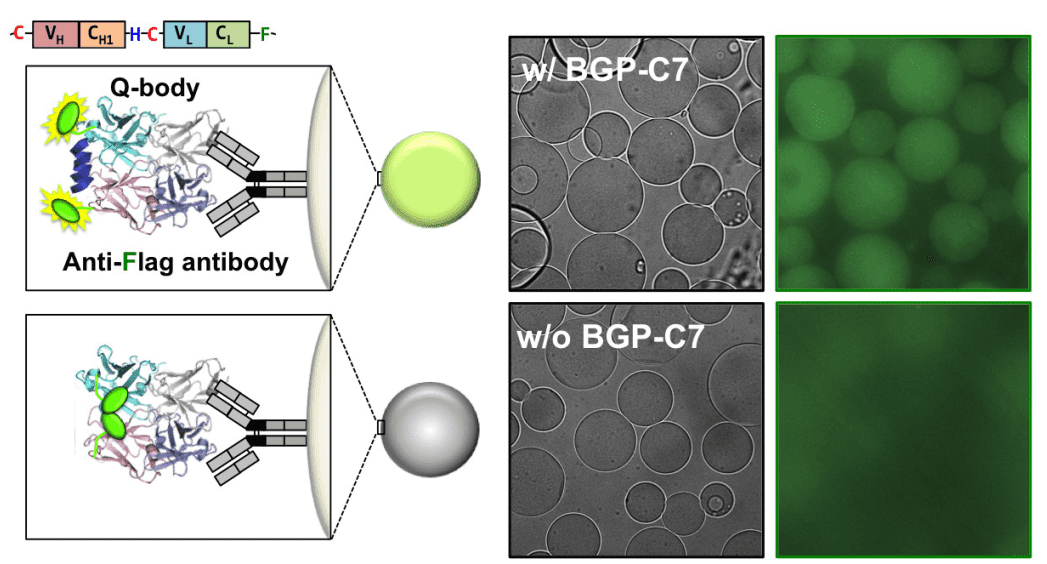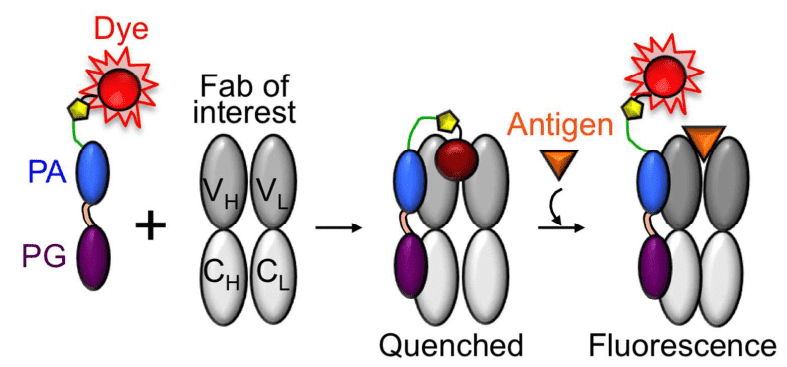Quenchbody Development
With years of experience in bio-conjugation chemistry, the science team at Creative Biolabs has established a platform to provide clients with Quenchbody (Q-body) development services for biotech as well as diagnostic applications. The featured “Q-body” opens a new route to achieve simple yet accurate immunoassays.
Quenchbody (Q-body)
Q-body is a new type of antibody-based probes that are highly innovative, versatile, and sensitive in detecting their corresponding antigens. It is constructed based on the principle of antigen-mediated fluorescent signal release. A Q-body is comprised of a fragment antibody (Fab or scFv) that is covalently modified by a fluorophore whose signal is, in the absence of the corresponding antigen, quenched by tryptophan (Trp) residues in the antibody. Upon antigen interaction, due to the change in antibody conformation, the Trp quenching effect is levitated, releasing the fluorescent signals. In principle, any antibody can be converted into a Q-body with proper protein engineering and conjugation strategies. The quenching effect is facilitated by adding of a small flexible linker that crosslinks the fluorophore to the Nt of the Fab or scFv antibody.
 Fig.1 Schematic representation of the microscopic observation of anti-Flag M2 beads with and without double ATTO520-labeled UQ-body. (Abe, 2014)
Fig.1 Schematic representation of the microscopic observation of anti-Flag M2 beads with and without double ATTO520-labeled UQ-body. (Abe, 2014)
PAxPG-based Quenchbody
PAxPG is a novel antibody binding protein that is comprised by combining the Staphylococcus protein A (PA) and Streptococcus protein G (PG) with a small peptide linker. PAxPG exerts high affinity towards the Fab region of an IgG antibody. The interaction affinity of PAxPG with the Fab region can be optimized by changing the linker length between the PA and PG domains. The PAxPG construct, coupled with a fluorophore, can be used as a “pre-Q-body” to convert essentially any Fab fragment into a Q-body. By interacting with any Fab antibody, the fluorescently tagged PAxPG construct insert the fluorophore into the antigen binding site, subsequently quenching the fluorescent signal. Upon antigen interaction, the fluorescent signal is again released by the structural change in the antigen-binding domain, validating the antigen binding. Compared with conventional Q-bodies, PAxPG-based Q-body is highly advantageous in the application to a wider range of antigen size (antigens from haptens to proteins), a wider selection of fluorescent dyes, as well as no chemical or genetic modifications to the Fab antibody.
 Fig.2 Scheme for labeled Q-body and its antigen-dependent fluorescence. (Jeong, 2016)
Fig.2 Scheme for labeled Q-body and its antigen-dependent fluorescence. (Jeong, 2016)
Applications of Quenchbody
The Q-body system is designed for high accuracy antigen recognition as well as quick antigen detection, validation, and quantification. As a novel antibody-based probe, Quenchbodies have a wide application in cancer diagnostics, in vitro/in vivo imaging, and in the development of next-generation molecular probes. What’s worth mentioning is that facilitated by new methods of orthogonal conjugation handle incorporation (e.g. unnatural amino acids), Q-bodies, especially PAxPG-based Q-bodies, have been empowered with a variety of conjugation chemistries to incorporate a wide range of fluorescent dyes, making them ideal candidates for the development of modern diagnostic devices as well as dual labeling (e.g. calmodulin and MBP) for FRET-based biosensor preparations.
Features of Quenchbody
- High sensitivity
- Easy to prepare
- High selectivity
- Compatible with a large variety of dyes
Experienced in antibody chemistry and with a dedicated commitment to the scientific community, Creative Biolabs has perfected our technical pipelines in the development of diverse Q-body. We would like to share our knowledge and passion in this field to promote the advances of science. Please contact us for more information and a detailed quote.
References:
- Jeong, H. J.; et al. One-pot construction of Quenchbodies using antibody-binding proteins. Analytical Methods. 2016, 8(43), 7774-7779.
- Jeong, H. J.; et al. Q-Bodies from Recombinant Single-Chain Fv Fragment with Better Yield and Expanded Palette of Fluorophores. ACS Sensors. 2015, 1(1), 88-94.
- Abe, R.; et al. Ultra Q-bodies: quench-based antibody probes that utilize dye-dye interactions with enhanced antigen-dependent fluorescence. Scientific reports. 2014, 4, 4640.
For Research Use Only. NOT FOR CLINICAL USE.

Online Inquiry
Welcome! For price inquiries, please feel free to contact us through the form on the left side. We will get back to you as soon as possible.
